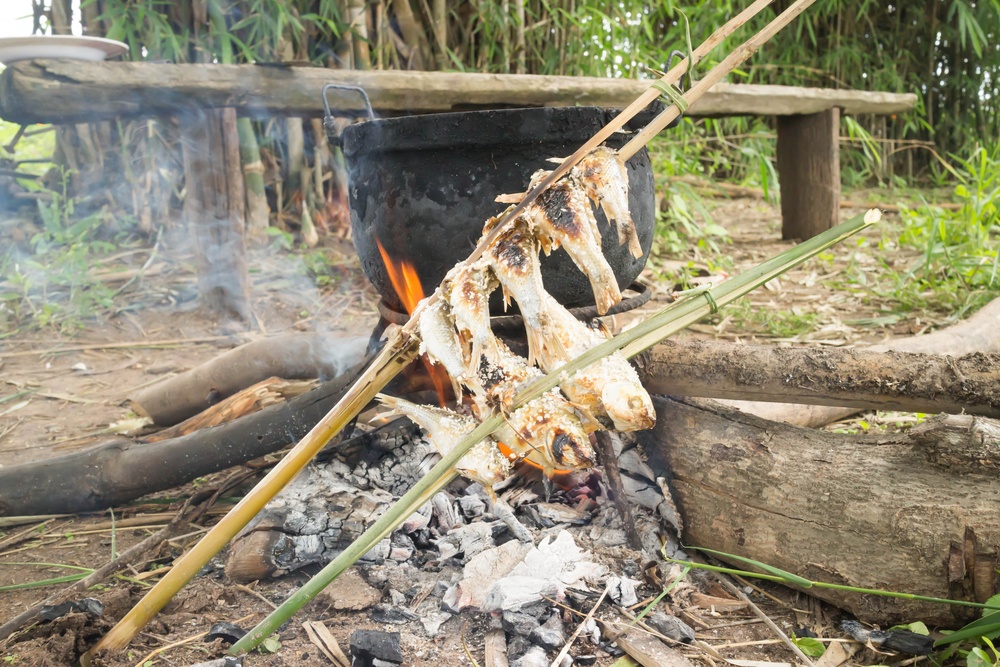How to Cook a Fish in the Wild


Eating The Invasives
When it comes to the world of fishing, there are few things better than hooking a fish, knocking it out, cleaning it, and cooking it. By cooking the fish at the peak of freshness, you can get a delicate, tender taste unlike any other.
Still, though, most people opt not to cook fish in the wild, instead sticking them in a fish box or packing them on ice for the return trip home, and cooking them in standard ovens or on the stove top.
And that’s a shame – though there’s nothing wrong with cooking your fish at home, there’s just something special about starting a fire, charring your new catch, and digging in – caveman style.
Cooking a fish in the wild isn’t easy, though – you’ll need some tools, a bit of know-how, and some quick and easy instructions on the basics of cooking your fish – without totally torching it and rendering it inedible.
So read on. We’ll go over the basics of cooking fish in the wild, and give you some easy-to-follow guidance on ensuring your fresh, wild fish is cooked tender and seared to perfection, even over a campfire.
What You’ll Need
The actual tools you’ll need to catch and cook a fish are quite simple:
- A high-quality stainless steel knife: A pocket knife works as fish fillet knife if you know the technique. The sharper, the better, as this will make cleaning the fish much easier, and reduce the risk that your knife will slip and cut you.
- Fishing Gear: A rod and reel, whatever you have that’s appropriate for the area and water conditions in which you’re fishing. Even an improvised stick, line, and hook will grab you a fish eventually.
- Fire starter: a backpacking flint works, as does a lighter, or even simple matches. You’ll need to build a fire to cook your catch.
And that’s pretty much it. You can get fancier with gear, such as camp stoves for cooking your catch, specialized fish-gutting knives, and so on, but in the spirit of keeping it simple, those three pieces of gear are all you need to catch and cook your fish.
Best Cook a Fish 2021
Catching Your Fish
This step is pretty self-explanatory. Catch a fish! If you need some tips:
- Stay quiet. Fish notice shadows and movement.
- Change your fishing location after a few minutes without any bites.
- Cast your hook, ideally with a lure or bait if it’s available (worms and leeches can work well) near rocks, vegetation, and other places that can shelter prey fish.
Though if you’re reading this, you probably already know how to catch a fish. Still, the guide wouldn’t be complete without this step.
Knock Your Fish Out – And Get Gutting!
Be merciful. End the life of your fish quickly with a very hard blow to the head – knocking its head against your boat or a tree will do. Remove the hook.
- Insert the tip of your knife into the belly of the fish, near the tail end. Cut all the way up toward the head – keep the cut shallow so you don’t rupture the intestines.
- Spread the body open in a “V” and scrape out all of the entrails. Cut out the anus of the fish.
- Look for a dark strip near the backbone. If present, that’s a kidney – scrape it out with the back of your knife.
- Rinse out the interior cavity and wash the skin – drinking water or a quick-running stream is good for this. The latter is likely more appropriate if you’re in a survival situation and want to ration your bottled water. Lakewater is less-than ideal for rinsing the fish, but can do in a pinch.
- Cut off the head and fins. The head can be left on, if desired, but the fins are quite sharp, and unappetizing when the fish is cooked whole.
- If cooking the fish whole, you may scrape off the scales with your knife – but in smaller fish, this is often unnecessary.
You’re done! You can debone and fillet your fish if you want, but in an effort to make things easy, we’ll be using a very easy cooking method with as little preparation as possible.
Start Your Fire
This step should be done early if you’re hungry – you’re going to have to wait for the fire to burn down to embers to use our cooking technique. So find some tinder, dry branches, and sticks, and make your fire. Toss on some larger logs and make sure that it’s burning well (and don’t abandon it once it’s started).
Once your fire has reduced to coals and embers, it’s time to cook.
Cooking Your Fish
- Find some broad leaves – any that are big enough to wrap around your fish without falling off.
- Wrap your catch up in the leaves – the greener, the better. Several layers is preferable so that the flesh isn’t directly exposed if one layer burns off. Cooking over a fire is very difficult – temperatures can vary widely. By wrapping your catch with leaves, you can ensure even cooking by reducing the impact of “hot spots” on the cooking process.
- Once your fish has been wrapped, stick it right on the coals and embers of your fire. There should be plenty of heat there, but not so much that your fish gets scorched and becomes carbonized.
- Flip the fish once, about halfway through cooking.
- Remove when an inspection of the fish reveals the flesh has turned opaque and is cooked through.
- Enjoy!
A good rule of thumb for doneness is about 10 minutes per inch of fish thickness. You can eat the fish with a knife and fork, or just take it apart by hand. Eating by hand can be better for smaller fish – you’ll be able to feel and avoid small bones that you might otherwise eat.
Wrap-Up
That’s it! Cooking a fish in the wild is really just a matter of catching one, knowing a bit about field cleaning techniques, and having the proper fire and cooking techniques.
So get out there, catch a fish, and cook it in the wild. The flavors are spectacular, and the experience is like no other.






